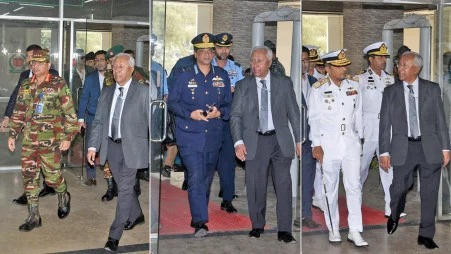Commission: Enforced disappearance victims faced brutal, methodical torture
- Update Time : Friday, December 20, 2024

BSS
The Commission of Inquiry on Enforced Disappearance has revealed that victims of enforced disappearance have endured inhuman torture in secret detention centres systemically.
“The accounts of torture we have documented are both profoundly brutal and disturbingly methodical,” the commission said in its report.
The five-member commission, led by retired justice Mainul Islam Chowdhury, handed over the report titled “Unfolding The Truth” to Chief Adviser Dr Muhammad Yunus at the state guest house Jamuna on Saturday.
The commission’s findings highlighted a notable distinction between premises managed by military officers and those overseen by civil forces, such as the police.
In facilities under civil forces like the DB (Detective Branch) and CTTC (Counter Terrorism and Transnational Crime), torture was integrated into daily operations.
“Our findings indicate that although specialized torture equipment was used, the acts of torture were conducted routinely within the same space occupied by security personnel,” according to the report.
Detainees reported witnessing officers calmly working at their desks or computers—unperturbed by the screams of agony—suggesting a disturbing normalization of such practices.
Conversely, premises controlled by military commanders, such as those managed by RAB (Rapid Action Battalion) and DGFI (Directorate General of Forces Intelligence), displayed a more specialized infrastructure for torture.
These facilities were often equipped with soundproofed chambers and mechanized instruments explicitly designed for inflicting physical and psychological harm.
“While we are withholding detailed descriptions of these facilities to safeguard the integrity of our ongoing inquiry, we will provide a comprehensive account in the Commission’s final report,” the commission stated.
The report mentioned two harrowing examples to illustrate the severity of torture practices.
In one instance in 2010, a young man abducted by RAB from Dhanmondi was taken to a room where his lips were sewn without anesthesia.
He described the experience as akin to stitching cowhide, underscoring the dehumanization inflicted upon him.
In another case, eight years later, a middle-aged man recounted being subjected to electrocution on his genitals and ears.
This torture also occurred at the RAB facility.
The consistency in these practices, despite temporal and geographical differences, indicates systemic and institutionalized methods of torture.
The findings highlight the calculated and pervasive nature of torture within these entities and stress the urgent need to address structural and cultural factors enabling these practices.
The report said that victims of enforced disappearances typically exit the system through two channels: either they are killed, or they are released into the criminal justice system.
A very small minority are released without charges, as seen with victims released after the August 5 changeover.
For those killed, the commission received verified reports detailing methods of execution.
Post-mortem examinations of recovered bodies revealed that victims were shot in the head and disposed of in rivers with cement bags tied to their bodies.
This method, described by military officers who served in RAB, was standard procedure to ensure the bodies sank.
Specific sites of killing and disposal mentioned in the report include the Buriganga River, Kanchon Bridge, and Postogola Bridge.
The Postogola Bridge location notably featured a boat—confiscated during a raid on a pirate den in the Sundarbans—modified for these operations.
Officers were often active participants in these executions.
One witness, a RAB battalion commander, recounted an “orientation” session conducted by the then-head of RAB Intelligence Wing, during which two victims were shot on a bridge as part of his initiation into RAB.
Another soldier, previously deputed to RAB Intelligence, described retrieving a victim who attempted to escape by jumping into a river, only to execute him on the spot.
The report also documented alternative methods of killing.
In one case, a soldier was ordered to place a body on railway tracks in Dhaka, where it was dismembered by a passing train.
In another instance, a surviving victim described being pushed onto a highway in front of an oncoming vehicle, which narrowly missed him.
The officer abandoned the attempt, sparing the victim’s life.
These accounts underscore the varied but uniformly brutal methods of execution, designed to eliminate victims and often conceal their remains.
The systemic nature of these practices, involving multiple locations and agencies, disproves claims of rogue officers and highlights coordinated efforts behind these crimes.













